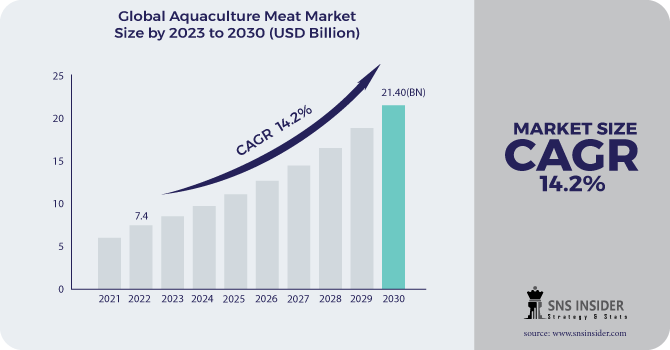Aquaculture Meat market Market scope & Overview:
The Aquaculture Meat market size was valued at USD 7.4 Bn in 2022 and is expected to reach USD 21.40 Bn by 2030, and grow at a CAGR of 14.2% over the forecast period of 2023-2030.
There has been an immense growth in the rise of demand for seafood all around the globe. The aquaculture market is basically the fish farming process which includes several activities such as feeding them, protecting them from danger also keeping track of them, Aquaculture is a major form of business for many farmers all around the globe, and there has been a growth in the production of fish farming around the ocean to meet the rising demand of the seafood.

Impact of COVID-19
During the outbreak of covid 19, it became difficult for the aquaculture market to grow because of the supply chain disruptions, and also the delivery sources were not available due to the lockdown rules imposed by the government. The post-pandemic situation is been stabilized due to the increase in demand for sea foods and also due to the increase in production and the awareness of consumption of seafood.
Market Dynamics
Drivers
- Increase in demand for seafood all around the globe.
Restrains
-
The rise in adoption of veganism, and also the ongoing trend of veganism
Opportunities
-
The increase in the consumption of fish and the chance of an increase in profitability is due to the same.
Challenges
-
Rules and regulations against animal killing are the biggest challenges for the aquaculture market.
Market Segmentation
By Product Type
-
Equipment
-
Pharmaceuticals
-
Fertilizers
By Culture
-
Freshwater
-
Brackish Water
-
Marine
By Species
-
Aquatic Plants
-
Aquatic Animals
.png)
Impact of Russia Ukraine war
Impact of Russia Ukraine war had a great impact on the seafood sector as the overall prices of raw materials led to an increase in the operating cost for aqua farmers, and fishermen. The European Commission has responded with energy measures and adapting state aid rules which had a negative impact on the aquaculture market.
Impact of Current Ongoing recession
The aquaculture market may have little impact due to the recession as there will be an economic barrier for every individual, also the trend of adopting veganism all around the globe may be the restraining factor for this market during the recession.
Regional Analysis
Asia Pacific will be expected to dominate the aquaculture market with the immense growth of market share due to the rise in demand for sea foods and also because of the benefits which come along with the consumption of sea foods.
By region
-
North America
-
USA
-
Canada
-
Mexico
-
-
Europe
-
Germany
-
UK
-
France
-
Italy
-
Spain
-
The Netherlands
-
Rest of Europe
-
-
Asia-Pacific
-
Japan
-
South Korea
-
China
-
India
-
Australia
-
Rest of Asia-Pacific
-
-
The Middle East & Africa
-
Israel
-
UAE
-
South Africa
-
Rest of Middle East & Africa
-
-
Latin America
-
Brazil
-
Argentina
-
Rest of Latin America
-
Key Players
The major key players are Aquaculture Technologies for ASIA Ltd, Alpha group Ltd, CERMAQ Group As, Marine Harvest Asa, Thai Union Group, Pentair plc, AKVA group, Xylem, Luxcol, Lifeguard Aquatics.
Alpha group Ltd-Company Financial Analysis


